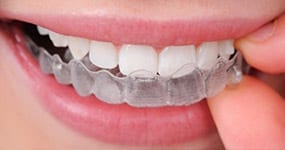Clear guide to Invisalign attachments

Invisalign has changed the game for teeth straightening—offering a clear, comfortable, and discreet alternative to braces. But did you know that some smiles need a little extra help to get the perfect results? That’s where Invisalign attachments come in.
These tiny, tooth-coloured bumps might not be as well-known as the aligners themselves, but they play a crucial role in fine-tuning your smile. Think of them as secret agents—small but mighty tools that help guide your teeth into their ideal position with precision.
If you’re starting your Invisalign journey or just curious about how these little helpers work, you’re in the right place. In this guide, we’ll break down everything you need to know about Invisalign attachments—how they work, their benefits, when they’re needed and what to expect.
What are Invisalign attachments?
Invisalign attachments are tiny, tooth-coloured bumps made of dental composite that are bonded to specific teeth during Invisalign treatment. They act as grip points, helping your aligners apply precise pressure to move teeth more precisely and effectively.
Designed to blend seamlessly with your natural teeth, Invisalign attachments are made from a discreet resin material, making them far less noticeable than traditional braces. They are strategically placed based on your customised treatment plan, supporting targeted tooth movement for optimal alignment.
Each attachment is specially shaped and placed to help your aligners work better. They give extra support for tricky movements, like turning or shifting teeth, making the straightening process more precise and effective.
By providing extra leverage, these attachments help your aligners fit snugly and work more efficiently—bringing you closer to your perfect smile.
How do Invisalign attachments work?
Invisalign attachments act like tiny anchor points, giving your aligners a better grip to guide your teeth into alignment. Placed on specific teeth that require extra movement, these small, tooth-coloured bumps help your aligners apply precise pressure exactly where it’s needed.
By securely holding onto the attachments, your aligners can exert controlled forces in targeted directions, ensuring gradual and effective tooth movement. This added support allows Invisalign aligners to tackle more complex shifts, helping you achieve a straighter smile more efficiently.
Do I need Invisalign with attachments?
Not all Invisalign treatments require attachments—they are typically recommended for patients who need extra support to achieve precise tooth movement.
Your orthodontist can determine this based on your unique case. During your initial consultation, a digital treatment plan will map out whether attachments are necessary to help align your teeth or correct bite issues effectively.
Here are some common reasons why Invisalign attachments might be needed:
Vertical movements
If a tooth needs to be moved up (intruded) or pulled down (extruded), attachments can provide the necessary leverage. Whether it needs to be pushed deeper into the gum or brought down to match the others, they make sure the movement is controlled and accurate.
Tooth rotations
Some teeth are tricky to move, especially if they’re severely rotated or misaligned. Attachments act like tiny handles, helping aligners apply controlled rotational forces to gently reangle the tooth into the right position.
Bite alignments
For patients with bite issues such as deep bites or open bites, attachments play a key role in adjusting jaw alignment. Strategically placed, they help direct the aligner’s force to reposition teeth and improve overall bite function.
Spacing issues
Attachments allow for more exact control over how and where teeth shift, making them particularly useful for complex spacing issues. They provide extra stability for a smoother and more predictable treatment process.
How many attachments will I need?
These Invisalign buttons aren’t placed on every tooth. Attachments are typically placed on teeth that need extra support for rotation, vertical movement, or bite correction.
That means the number and placement of attachments depend on your specific orthodontic needs. Some patients may need attachments on just a few teeth, while others might require more to achieve precise tooth movement.
Your orthodontist will customise their placement based on your treatment plan to achieve the best possible results.
How are Invisalign attachments applied?
The process of putting Invisalign attachments on your teeth is quick and carefully planned using advanced digital technology. Each step is designed to maximise the aligners’ grip and guide your teeth into the correct position for the best possible results.
Here’s what to expect:
1. Digital smile mapping
Your orthodontist creates a virtual model of your teeth using 3D imaging technology. This simulation predicts tooth movement and determines where attachments should be placed for the best results.
2. Prepping the surface
To bond the attachments properly and securely, the surface of your teeth is cleaned and slightly roughened.
H3: 3. Precise placement with a custom template
A specially designed stencil-like template is placed over your teeth, marking the exact spots where the attachments will go.
4. Applying the tooth-coloured composite
The attachment material—a dental composite that matches your tooth colour—is applied into the designated spaces in the template.
H3: 5. Securing with light activation
A special curing light hardens the composite, locking the attachments in place. Once the template is removed, any excess material is polished away.
6. Aligner fitting & instructions
With your attachments in place, your orthodontist will guide you through inserting and removing your aligners for a comfortable fit and effective movement.
Once your Invisalign journey is complete, the attachments are gently removed, and your teeth are polished back to their natural smoothness. To maintain your new smile, you’ll receive clear retainers designed to keep your teeth in their perfect position.
Do attachments hurt?
No, Invisalign attachments don’t hurt when they’re applied or removed. However, you might feel slight pressure or discomfort at first, similar to when you switch to a new aligner tray. This is normal and means your teeth are adjusting to the treatment.
Any soreness usually fades within a few days and can be managed with over-the-counter pain relief if needed. You may also find that inserting and removing your aligners feels a bit tighter at first, as the attachments create a snugger fit. With practice, this will become easier.
The benefits of Invisalign attachments
Invisalign attachments play a key role in improving the effectiveness of clear aligners, helping to achieve more precise and predictable tooth movement. Here’s how they can enhance your treatment:
More accurate movement
Attachments provide extra grip and stability, allowing Invisalign to move teeth with greater precision. They are especially helpful for complex shifts, such as rotations, vertical movements, and bite corrections, ensuring your treatment progresses as planned.
Quicker treatment
By improving the aligner’s ability to apply targeted pressure, attachments can help teeth shift more efficiently. This can reduce overall treatment time compared to cases without attachments.
Subtle appearance
Made from tooth-coloured resin, Invisalign attachments are designed to be discreet. They match the shade of your natural teeth and remain barely visible—especially when wearing your aligners.
Superior comfort
Unlike metal brackets and wires, attachments are small, smooth, and only placed on teeth that need extra support. This can reduce irritation and boost comfort throughout your Invisalign experience.
Are Invisalign attachments visible?
Invisalign attachments are designed to be as discreet as possible. Made from clear or tooth-coloured composite material, they blend in with your natural teeth, making them barely visible to others. Their small size and low profile mean they are far less noticeable than traditional braces.
While you may feel the attachments when your aligners are off, they are not easily seen. Your orthodontist will carefully match their colour to your teeth for a seamless look. If you have any concerns about visibility, discuss them with your provider—they can ensure the attachments are placed as discreetly as possible.
Do Invisalign attachments damage teeth?
No, Invisalign attachments do not damage your teeth when applied and removed correctly by a trained orthodontist. They are made from a safe, tooth-coloured composite material that bonds temporarily to your teeth and is easily removed at the end of your treatment without causing harm.
However, attachments can be prone to staining over time, especially if exposed to coffee, tea, red wine, or certain foods. To keep them looking their best, maintain good oral hygiene by brushing and flossing regularly. Using a whitening toothpaste can also help prevent and reduce staining.
If you notice any discoloration, your orthodontist can provide guidance on keeping your attachments clean and ensuring your smile stays bright throughout your Invisalign journey.
How long will I have to wear Invisalign attachments for?
The length of time you’ll need Invisalign attachments depends on your personalised treatment plan. In most cases, they stay in place for the entire duration of treatment, which can be as short as six months or longer for complex cases.
Your orthodontist will give you a tailored timeline based on your specific alignment needs and treatment goals. Once your teeth have shifted into their ideal position, the attachments will be safely removed.
6 tips for taking care of Invisalign attachments
As these attachments stay bonded to your teeth for most of your treatment, a little extra care goes a long way in keeping them secure and ensuring your aligners work effectively.
Follow these simple yet essential tips to keep them in top condition:
- Use your fingertips, not your nails or teeth, when handling aligners. Applying too much force can damage the attachments or cause unnecessary wear on your trays.
- Gently ease your aligners off using both hands, starting from the back. Avoid pulling or twisting too hard, as this can loosen your attachments over time.
- Brush your teeth twice a day—or ideally after every meal—to prevent plaque from building up around your attachments. A clean smile means clearer aligners and a smoother treatment process.
- Hard, sticky, or chewy foods can put pressure on your attachments and increase the risk of them popping off. Opt for softer, attachment-friendly foods to keep everything intact.
- Stay on schedule with check-ups. Your orthodontist will keep an eye on your progress and make sure your attachments are still working as they should. Don’t skip those appointments.
- Commit to 22 hours a day. Wearing your aligners for the recommended time ensures your attachments do their job efficiently. And remember—clean your aligners before popping them back in.
Book an appointment for Invisalign in Newcastle, NSW
Invisalign offers a personalised, nearly invisible way to straighten your teeth without the hassle of traditional braces. With custom-made aligners and carefully placed attachments, this treatment is designed to correct misalignment and bite issues while blending seamlessly into your smile.
Ready to transform your smile with Invisalign?
Contact ABC Orthodontics at 1300 794 797 to book your orthodontic treatment consultation in Newcastle, and take the first step toward a confident smile today!



